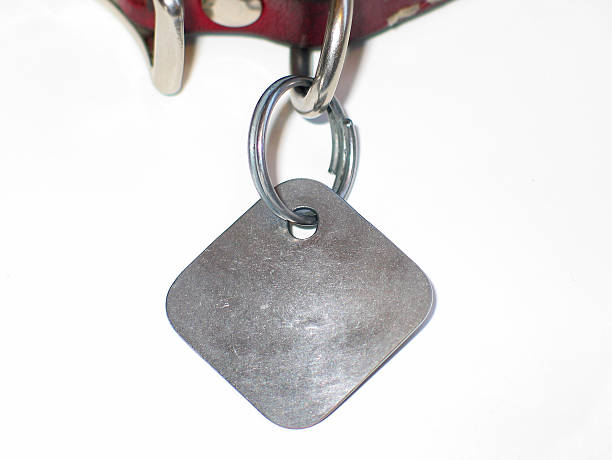The Ultimate Guide to Choosing the Perfect Pet ID Tag

Introduction
Choosing the perfect pet ID tag might seem like a simple task, but it’s one of the most important decisions you’ll make for your furry friend. A well-chosen pet ID tag ensures that your pet can be quickly and safely returned to you if they ever get lost. This guide will walk you through everything you need to know about selecting the ideal ID tag for your pet, from understanding the various types available to making sure it fits your pet perfectly.

Understanding the Purpose of a Pet ID Tag
Safety and Security
The primary purpose of a pet ID tag is to ensure your pet’s safety. In the unfortunate event that your pet goes missing, an ID tag provides crucial information that can help them be returned to you. The quicker someone can contact you, the less time your pet spends lost and vulnerable.
Legal Requirements
In many places, having an ID tag on your pet is not just a good idea; it’s a legal requirement. Laws often mandate that pets must wear tags with specific information, such as the owner’s name and contact number, and sometimes even proof of vaccinations.
Peace of Mind for Pet Owners
Knowing that your pet has an ID tag gives you peace of mind. It’s a simple yet effective way to ensure that, no matter where your pet goes, they can always find their way back to you.
Types of Pet ID Tags
Traditional Metal Tags
Traditional metal tags are the most common type of pet ID tag. They are typically made of stainless steel, aluminum, or brass and can be engraved with your pet’s name and your contact information.
Personalized Engraved Tags
Personalized engraved tags take traditional tags to the next level by offering a range of customization options. You can choose the shape, color, and engraving style to make the tag uniquely yours.
Digital Pet ID Tags
Digital pet ID tags are a modern alternative that uses QR codes or NFC technology to store your contact information. When someone finds your pet, they can scan the tag with their smartphone to access your details.
Smart Pet Tags with GPS
For the tech-savvy pet owner, smart pet tags with GPS tracking are the ultimate in pet safety. These tags allow you to track your pet’s location in real-time using a smartphone app, providing added security.
Material Options for Pet ID Tags
Stainless Steel
Stainless steel is one of the most durable materials available for pet ID tags. It’s resistant to rust, corrosion, and wear, making it ideal for pets who spend a lot of time outdoors.
Aluminum
Aluminum tags are lightweight and come in a variety of colors. They are a good choice for smaller pets, though they may not be as durable as stainless steel.
Brass
Brass tags offer a classic, vintage look. While they are durable, they do tend to tarnish over time, which can give them an aged appearance.
Silicone and Rubber
For pets with allergies or sensitivities to metal, silicone and rubber tags are a great alternative. They are soft, flexible, and available in a range of fun colors and designs.
Design and Shape Choices
Classic Shapes (Round, Bone, Heart)
Classic shapes like round, bone, and heart are popular choices for pet ID tags. They are simple, easy to read, and provide ample space for engraving.
Novelty Shapes (Stars, Paw Prints)
If you want to add a bit of personality to your pet’s ID tag, novelty shapes like stars or paw prints are a fun option. These tags stand out and can reflect your pet’s unique character.

Size Considerations
When choosing a tag, size matters. The tag should be large enough to fit all the necessary information but small enough to be comfortable for your pet to wear.
Engraving and Personalization
What Information to Include
At a minimum, your pet’s ID tag should include their name and your contact number. You might also consider adding your address, an alternate phone number, and any medical conditions your pet has.
Double-Sided Engraving
If you need to include a lot of information, consider a double-sided tag. This allows you to put your pet’s name and your contact information on one side and additional details on the other.
Durability and Longevity
Weather Resistance
If your pet spends a lot of time outdoors, you’ll want a tag that can withstand the elements. Look for tags that are advertised as weather-resistant to ensure they hold up over time.
Scratch and Wear Resistance
Tags that scratch easily can become unreadable, defeating their purpose. Choose a material that resists scratching and wear to keep your pet’s information legible.
Waterproof Options
For pets that love to swim or play in the rain, a waterproof tag is essential. These tags won’t rust or degrade when exposed to moisture, ensuring they last longer.
Attachment Methods
Split Rings
Split rings are the most common method of attaching a pet ID tag to a collar. They are simple to use but can sometimes come undone, so it’s important to check them regularly.
S-Hooks
S-hooks are a more secure alternative to split rings. They are less likely to come undone but can be tricky to attach without the proper tools.
Slide-On Tags
Slide-on tags fit directly onto the collar, reducing the risk of them coming loose. They are a good option for active pets who might lose a dangling tag.
Breakaway Collars
For safety-conscious pet owners, breakaway collars are designed to release if they get caught on something. Ensure that the tag is securely attached to prevent it from falling off.
Where to Buy Pet ID Tags
Online Retailers
Online retailers offer a wide variety of pet ID tags, often at competitive prices. You can find everything from basic metal tags to fully customized options.
Custom Pet Tag Makers
For something truly unique, consider ordering from a custom pet tag maker. These artisans can create a one-of-a-kind tag that reflects your pet’s personality.
Cost Considerations
Budget-Friendly Options
If you’re on a tight budget, there are plenty of affordable pet ID tags available. Basic metal tags are inexpensive and still provide the necessary protection for your pet.
Premium Custom Tags
For those willing to spend a bit more, premium custom tags offer a range of benefits, including higher-quality materials, unique designs, and added features like GPS tracking.
Balancing Cost and Quality
When choosing a pet ID tag, it’s important to balance cost with quality. A slightly higher investment in a durable, well-made tag can save you
money and hassle in the long run, as it will last longer and provide better protection for your pet.
How to Properly Attach a Pet ID Tag
Step-by-Step Guide
Attaching a pet ID tag properly is essential to ensure it stays secure on your pet’s collar. Here’s a simple step-by-step guide:
Choose the Right Attachment: Whether you’re using a split ring, S-hook, or slide-on tag, make sure the attachment method is appropriate for your pet’s collar.
Open the Attachment: If you’re using a split ring, gently pry it open with your fingernail or a small tool. For S-hooks, you may need pliers to open them slightly.
Slide the Tag Onto the Attachment: Carefully thread the ID tag onto the split ring or S-hook. Ensure it’s securely attached and not likely to slip off.
Attach the Tag to the Collar: Loop the split ring or S-hook through the D-ring on your pet’s collar. If using a slide-on tag, thread the collar through the tag’s slot.
Close the Attachment: If using a split ring, rotate it back to its original closed position. For S-hooks, use pliers to crimp the hook closed, ensuring it’s tightly secured.
Check the Fit: Once the tag is attached, check that it’s not too loose or too tight. The tag should hang comfortably without dragging on the ground or being too close to the collar.

A blank dog tag.
Ensuring a Secure Fit
Regularly check your pet’s ID tag to make sure it’s still securely attached. Over time, attachments can wear out, so it’s important to inspect them periodically and replace them if necessary.
Regular Maintenance and Checking
Just as you would check your pet’s collar for wear and tear, you should also inspect their ID tag regularly. Look for signs of rust, scratches, or fading, and replace the tag if it’s become unreadable.
Caring for Your Pet’s ID Tag
Cleaning and Polishing
To keep your pet’s ID tag looking its best, clean it regularly with mild soap and water. For metal tags, you can use a polishing cloth to remove tarnish and restore shine. Steer clear of strong chemicals that might harm or wear down the engraving.
Replacing Worn-Out Tags
Over time, even the most durable tags can wear out. If your pet’s tag becomes scratched, faded, or difficult to read, it’s time to replace it. A fresh, legible tag ensures your pet’s safety.
Preventing Rust and Damage
To prevent rust, choose a rust-resistant material like stainless steel for your pet’s ID tag. If your pet spends a lot of time in wet conditions, consider a waterproof tag to avoid damage.
Common Mistakes to Avoid
Incomplete Information
One of the most common mistakes pet owners make is not including enough information on the ID tag. Make sure to include your pet’s name, your phone number, and any other important details that could help someone return your pet to you.
Choosing the Wrong Material
Not all materials are created equal. Choosing a tag made from a material that isn’t durable enough for your pet’s lifestyle can lead to it breaking or wearing out quickly. Consider your pet’s activities and environment when selecting the material.
Not Updating Information
If you move or change your phone number, don’t forget to update your pet’s ID tag. An outdated tag won’t be helpful if your pet gets lost, so make sure all information is current.
FAQs About Pet ID Tags
How frequently should I update my pet’s ID tag?
It’s a good idea to replace your pet’s ID tag whenever it shows signs of wear, such as fading or scratches. On average, checking it annually and replacing it every few years ensures that the information remains clear and legible.
What Should I Do If My Pet Loses Its ID Tag?
If your pet loses its ID tag, replace it as soon as possible. In the meantime, keep a backup tag on hand or consider having your pet microchipped for added security.
Are Smart Pet Tags Worth the Investment?
Smart pet tags with GPS tracking can be worth the investment if you want extra peace of mind. They offer real-time tracking and other advanced features that can be invaluable if your pet goes missing.
Can I Use a Pet ID Tag for My Indoor-Only Pet?
Yes, even indoor-only pets should wear ID tags. Accidents happen, and if your pet escapes, an ID tag increases the chances of a safe return.
How Can I Make My Pet’s ID Tag Stand Out?
To make your pet’s ID tag stand out, choose a unique shape, color, or design that reflects their personality. You can also add a reflective coating to improve visibility at night.
Conclusion
Choosing the perfect pet ID tag is a small but crucial step in ensuring your pet’s safety and security. By understanding the different types, materials, and features available, you can select a tag that meets your pet’s needs and provides peace of mind. Remember to keep the tag updated with current information and check it regularly for signs of wear. With the right ID tag, you can rest easy knowing that your beloved pet has a better chance of finding their way back home if they ever get lost.


